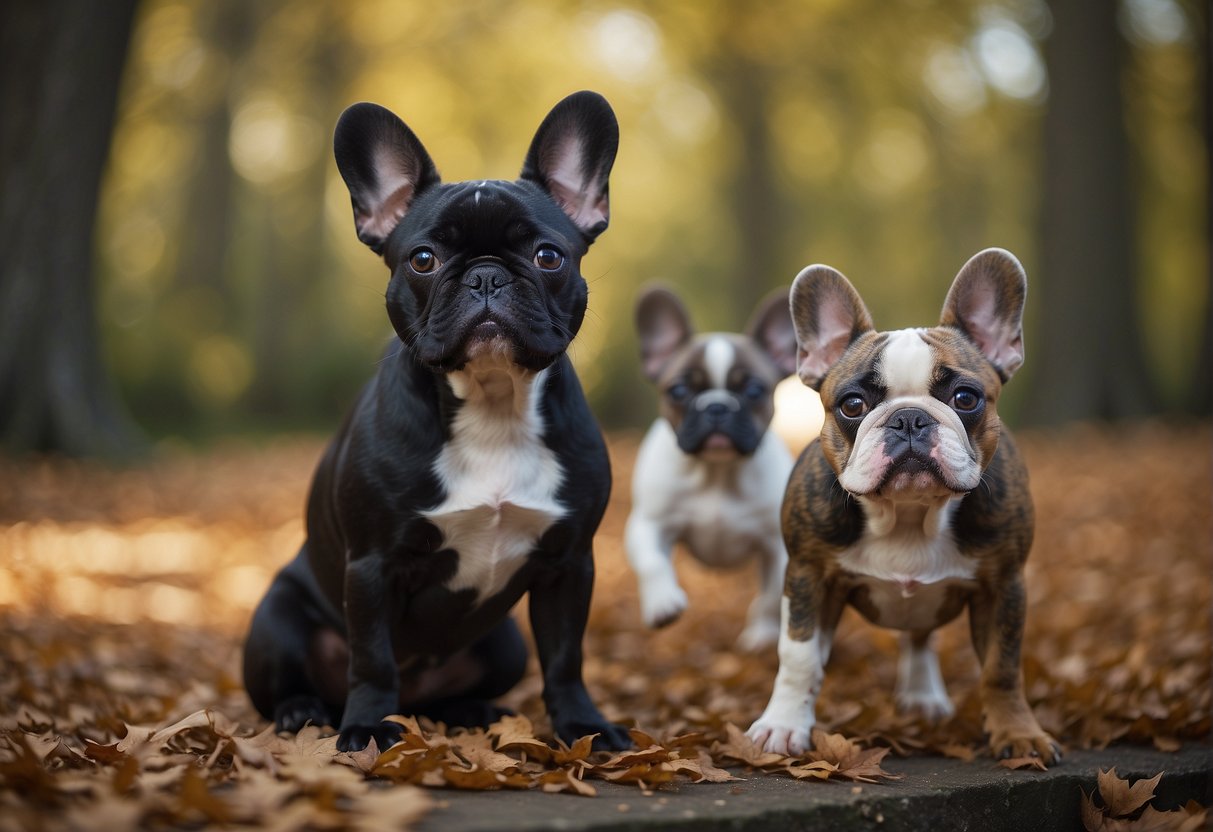Why French Bulldogs Were Bred: A Brief History
French Bulldogs are a small, adorable and cute breed that has become increasingly popular in recent years. However, many people may not know why this breed was originally bred. In this article, we will explore the history of French Bulldogs and the reasons behind their breeding.

French Bulldogs were originally bred in England in the 1800s. They were created as a smaller version of the English Bulldog, which was used for bull-baiting. However, the smaller size of the French Bulldog made it more suitable for indoor living, and it quickly became a popular companion dog. French Bulldogs were also popular with lace workers who moved to France, where they became known as “Bouledogues Francais.”
Despite their name, French Bulldogs are not actually French. They were brought to France by English lace workers in the late 1800s and quickly became popular with the French. They were used as companion dogs and were often seen in the company of wealthy Parisians. Today, French Bulldogs are still popular as companion dogs and are known for their affectionate and playful personalities.
Historical Background

French Bulldogs are a beloved breed today, but their origins are rooted in England. During the 18th and 19th centuries, bulldogs were bred for bull-baiting, a cruel sport in which dogs were set upon a tethered bull. The bulldog’s physical characteristics, such as its muscular body and powerful jaws, made it ideal for this purpose. However, as bull-baiting became illegal in England, bulldogs were no longer needed for this violent sport.
Origins in England
Instead, breeders began to focus on creating a smaller, more compact bulldog that could be kept as a companion animal. The early French Bulldog was created by crossing the English Bulldog with various small breeds, such as the Pug and the Terrier. The result was a dog that was smaller and more docile than its English counterpart, with distinctive bat-like ears and a flat face.
Migration to France
During the Industrial Revolution, many English lace workers migrated to France in search of work. They brought their toy bulldogs with them, and the breed quickly became popular in France. The French were particularly enamored with the dog’s unique appearance and affectionate nature. French breeders began to refine the breed, breeding for specific traits such as a smaller size and a more rounded head.
Popularity and Evolution
As French Bulldogs grew in popularity, they began to evolve into the breed we know today. By the late 19th century, the dogs had become a fixture in Parisian high society, beloved by artists such as Henri de Toulouse-Lautrec and a common sight in the cafes of Montmartre. In 1880, the French Bulldog Club was founded in Paris, and the breed was recognized by the French Kennel Club in 1898.
In conclusion, French Bulldogs were originally bred in England as a smaller, more docile version of the English Bulldog. They were brought to France during the Industrial Revolution by English lace workers and quickly became popular due to their unique appearance and affectionate nature. Over time, the breed evolved into the beloved companion animal we know today.
Physical Characteristics

French Bulldogs are a small breed of domestic dogs that are known for their distinctive features. In this section, we will discuss the physical characteristics of French Bulldogs, including their distinctive features, color, and markings.
Distinctive Features
One of the most distinctive features of French Bulldogs is their ears. They have bat-like ears that are set high on their head and are wide at the base. These ears give them a unique and adorable appearance that has made them popular as pets.
French Bulldogs are also known for their small size. They typically weigh between 16 and 28 pounds and stand about 11 to 12 inches tall at the shoulder. Their small size makes them ideal for apartment living, and they are also easy to transport.
Another characteristic of French Bulldogs is that they are brachycephalic, which means that they have a shortened skull. This feature gives them their adorable, wrinkled faces and their bat-like ears.
Color and Markings
French Bulldogs come in a variety of colors, including fawn, white, brindle, and cream. They may have a solid color or a combination of colors. Some French Bulldogs have a black mask on their face, while others have white markings on their chest and feet.
In conclusion, French Bulldogs are a unique and adorable breed of dogs that are known for their distinctive features, small size, and brachycephalic skulls. They come in a variety of colors and markings, which adds to their charm and popularity as pets.
Breed Standards and Recognition

French Bulldogs have become one of the most popular dog breeds in recent years, and for good reason. They are loyal, affectionate, and make great companions. But what makes a French Bulldog a French Bulldog? In this section, we will explore the breed standards and recognition of French Bulldogs.
American Kennel Club (AKC)
The American Kennel Club (AKC) is one of the most well-known kennel clubs in the world. It is also the oldest kennel club in the United States, having been founded in 1884. The AKC recognizes French Bulldogs as a breed and has established breed standards for them. According to the AKC, French Bulldogs should be small, compact, and muscular. They should have a short, smooth coat and a “bat ear” that is wide at the base and rounded at the top.
International Kennel Clubs
French Bulldogs are also recognized by a number of international kennel clubs. In Europe, the breed is recognized by the Fédération Cynologique Internationale (FCI), which is the largest kennel club in the world. The FCI has established breed standards that are similar to those of the AKC. In Australia, French Bulldogs are recognized by the Australian National Kennel Council (ANKC), and in the United Kingdom, they are recognized by the Kennel Club.
Overall, French Bulldogs have gained recognition and popularity around the world due to their unique appearance and affectionate personalities. The breed standards established by kennel clubs ensure that French Bulldogs maintain their distinctive characteristics and continue to be recognized as a distinct breed.
Temperament and Behavior

French Bulldogs are known for their charming personalities and affectionate nature. They are loyal and friendly dogs that love to be around people, making them great pets for families with children.
Personality Traits
French Bulldogs are sociable and playful dogs that enjoy being the center of attention. They are intelligent and quick learners, but can also be stubborn at times. They have a mischievous streak, and love to play and explore their surroundings.
Compatibility with Families
French Bulldogs are great companion dogs and make excellent family pets. They are affectionate and loving towards their owners, and enjoy spending time with them. They are also good with children, and are patient and gentle around them.
Overall, French Bulldogs are wonderful pets that are well-suited to families and individuals alike. Their friendly and sociable nature, combined with their intelligence and playfulness, make them a joy to be around.
Breed Purpose and Roles

French Bulldogs were originally bred to be companion dogs and lap warmers for lacemakers in England. They were also known as toy bulldogs due to their small size. The breed then made its way to France where it became popular among society ladies and writers.
Original Roles
The original purpose of French Bulldogs was to be a loyal companion to their owners. They were also used as watchdogs to alert their owners of any intruders. However, the breed was not originally bred for any specific work-related roles.
Modern-Day Roles
In modern times, French Bulldogs have become popular family pets due to their affectionate and friendly nature. They are also used as therapy dogs due to their calm and gentle demeanor. Additionally, they have been trained as service dogs for people with disabilities.
It should be noted that French Bulldogs are not typically used for hunting or other work-related purposes. They are primarily bred to be loving companions and lap dogs.
Overall, French Bulldogs have come a long way from their original role as lap warmers for lacemakers. They have become beloved family pets and companions, providing love and affection to their owners.
Health and Care

Common Health Issues
French Bulldogs are a brachycephalic breed, which means they have a short snout and flat face. This can lead to a variety of health issues, including breathing difficulties, overheating, and dental problems. As a result, it is important to monitor their health closely and take them to the vet regularly.
One common health issue that French Bulldogs may experience is hip dysplasia. This is a condition where the hip joint does not develop properly, leading to pain and discomfort. French Bulldogs may also be prone to allergies, skin irritations, and eye problems.
Care Requirements
To keep a French Bulldog healthy, it is important to provide them with proper care. This includes feeding them a nutritious diet, providing regular exercise, and monitoring their weight. French Bulldogs are prone to obesity, which can exacerbate their breathing difficulties and other health issues.
It is also important to provide regular dental care, as French Bulldogs are prone to dental problems. This includes brushing their teeth regularly and providing them with dental chews and toys.
In addition, French Bulldogs should be kept cool in hot weather to prevent overheating. They should also be monitored closely during exercise to ensure they do not become too tired or overheated.
Overall, with proper care and attention, French Bulldogs can live happy and healthy lives.
Cultural Impact

French Bulldogs have had a significant cultural impact on art and society. They have been represented in paintings, sculptures, and other forms of art, showing their popularity among high society during the Belle Époque.
Influence on Art and Society
During the 19th century, French Bulldogs were a popular breed among high society members in France. They were often depicted in paintings and sculptures, such as the famous painting “Le Chien” by French artist Pierre-Auguste Renoir. French Bulldogs were also featured in advertisements, further popularizing the breed.
In the United States, French Bulldogs gained popularity in the early 20th century, becoming a symbol of affluence and luxury. They were often seen in the company of Hollywood stars and other celebrities, further cementing their status as a fashionable breed.
Representation in Media
French Bulldogs have also been represented in media, including movies and television shows. In the movie “Due Date,” a French Bulldog named “Sunny” plays a prominent role. The breed has also been featured in popular television shows such as “Modern Family” and “New Girl.”
The French Bulldog Club of America was established in 1897 and has since played a significant role in promoting the breed in the United States. The breed has also been recognized by the Westminster Kennel Club, which has included French Bulldogs in its annual dog show since 1896.
Despite their association with sex workers in the past, French Bulldogs have become a beloved breed in many parts of the world, with their unique characteristics and charming personalities making them a popular choice for families and individuals alike.
Frequently Asked Questions

What was the initial purpose of breeding French Bulldogs?
French Bulldogs were initially bred as companion dogs. They were developed in England during the industrial revolution, where they were popular among the lace workers. The breed was later brought to France, where it became popular among the upper class.
How have French Bulldogs changed in appearance since the 1800s?
French Bulldogs have undergone significant changes in appearance since the 1800s. The breed was originally larger and more aggressive, but it was later bred to be smaller and more docile. The breed’s characteristic bat-like ears and squished face were also developed during this time.
What two breeds were crossed to create the French Bulldog?
The French Bulldog was created by crossing the English Bulldog with the Toy Bulldog. The breed was developed in the late 1800s and was initially called the Bouledogue Francais.
What role did French Bulldogs serve in Parisian society historically?
French Bulldogs were popular among the upper class in Parisian society, where they were kept as companion dogs. They were also used as watchdogs and were occasionally used for ratting.
How has the temperament of French Bulldogs evolved over time?
The temperament of French Bulldogs has evolved over time. The breed was originally bred to be more aggressive, but it was later bred to be more docile and friendly. Today, French Bulldogs are known for their sociable and friendly nature.
What historical functions did French Bulldogs fulfill apart from companionship?
Apart from companionship, French Bulldogs were used as watchdogs and ratting dogs. They were also used as lap warmers and were sometimes employed as therapy dogs.




![How Much Are French Bulldogs At Petland [Clarified]](https://onlyfrenchbulldog.com/wp-content/uploads/2024/06/how-much-are-french-bulldogs-at-petland-clarified_3117-768x550.jpg)

